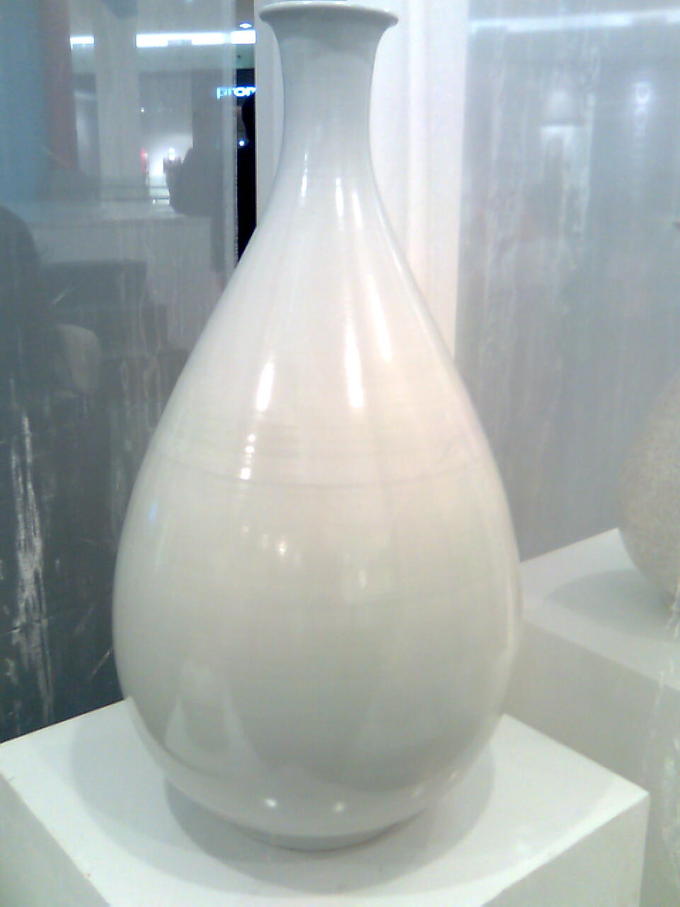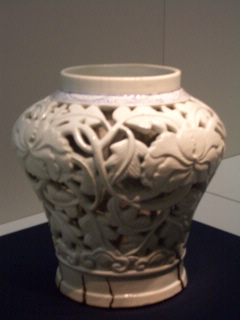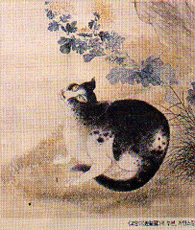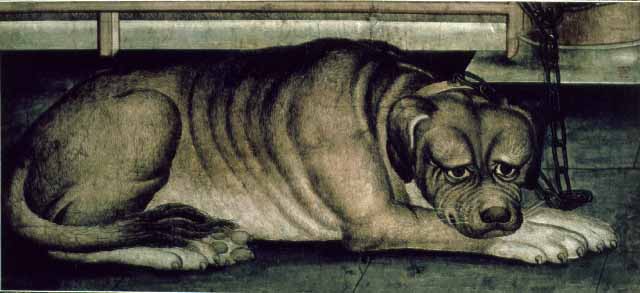12.6: Korea- The Joseon Dynasty
- Page ID
- 53092
Joseon Ceramics
Korea’s Joseon Dynasty (1392–1910) is considered the golden age of Korean pottery.
Learning Objectives
Identify the Ming, Confucian, and Buddhist influences on pottery created during Korea’s Joseon Dynasty
Key Takeaways
Key Points
- During Korea’s Joseon Dynasty , ceramic wares were considered to represent the highest quality of achievement from imperial, city, and provincial kilns , the last of which were export-driven wares.
- Wares evolved along Chinese lines in terms of color, shape, and technique, and the Ming influence in blue and white wares using cobalt blue glazes was evident in a great deal of Joseon pottery.
- Buddhist designs such as lotus flowers and willow trees prevailed in celadon wares. The form most often seen was that of pear-shaped bottles; also notable were thinner glazes and colorless glazes for buncheong or stoneware.
- The rise of white porcelain occurred as a result of Confucian influence and ideals, resulting in purer, less pretentious forms lacking artifice and complexity.
Key Terms
- Joseon Dynasty: Korean dynasty lasting from 1392 to 1910.
Overview: The Joseon Dynasty
During Korea’s Joseon Dynasty (1392–1910, often referred to as “Choson”), ceramic wares were considered to represent the highest quality of achievement from imperial, city, and provincial kilns, the last of which were export-driven wares. This era marked the golden age of Korean pottery, with a long period of growth in imperial and provincial kilns and much work of the highest quality still preserved today. Generally, the ceramics of this dynasty are divided into the early period (roughly 1300–1500), middle period (1500–1700), and late period (1700–1910).
Early Period
In the early period, wares were evolved alongside Chinese lines in terms of color, shape, and technique. Celadon, white porcelain, and storage pottery were similar but with slight variations in glazes, incision designs, florality, and weight. The influence of the Chinese Ming Dynasty (1368–1644) in blue and white wares using cobalt blue glazes could be seen in Joseon pottery, but Joseon work tended to lack the phthalo blue range and the three-dimensional glassine color depth of Ming Dynasty Chinese works. Ceramics from the Joseon period differed from other periods because artists felt that each piece of art deserved its own uniquely cultivated personality.
Simplified designs emerged early on during the Joseon Dynasty. Buddhist designs such as lotus flowers and willow trees prevailed in celadon wares. The form most often seen was that of pear-shaped bottles; also notable were thinner glazes and colorless glazes for buncheong or stoneware.

Joseon Dynasty pottery, Korea. Dongguk University Museum, Seoul: This blue and white porcelain jar with pine and bamboo designs was made in 1489 during the early Joseon Dynasty.
Middle Period
The middle period was marked by the Japanese invasion of Korea in 1592, during which entire villages of Korean potters were forcibly relocated to Japan. This had a permanent effect on the pottery industry in Korea, as craftsmen had to relearn techniques after the masters were gone. This era also saw the prolonged fall of the Chinese Ming Dynasty in 1644, after which immigration of some Chinese master potters occurred in southern coastal Korea. Qing coloring, brighter and almost Scythian in enamel imitation, was rejected by Korean potters in favor of simpler, less decorated wares in keeping with a new dynasty that built itself on military tradition.

Joseon white porcelain vase: White porcelains were preferred and praised more than any other porcelains during the Joseon period.
Late Period
The late period was characterized by the establishment of government-subsidized kilns at Bunwon-ri, Gwangju near Seoul in 1751, as well as the privatization of Bunwon in 1884. Joseon white porcelains became especially popular during this time and are characterized by unpretentious forms, understated decoration, and subtle use of color, reflecting the ideals of the Korean Confucian state. Over time, the wares began to assume more traditional Korean glazes and more specific designs to meet regional needs. The rise of white porcelain occurred as a result of Confucian influence and ideals, resulting in purer, less pretentious forms lacking artifice and complexity.

White porcelain jar, 18th century, Korea: The rise of white porcelain occurred as a result of Confucian influence and ideals, resulting in purer, less pretentious forms lacking artifice and complexity.
Joseon Painting
The art of the Joseon period was influenced by both Confucianism and Buddhism and has left a substantial legacy on Korean art.
Learning Objectives
Outline the evolution of Korean painting throughout the Joseon Dynasty
Key Takeaways
Key Points
- The influence of Confucianism superseded that of Buddhism in the Joseon period; however, Buddhist elements remained and Buddhist art continued.
- Buddhist iconography (such as images of bamboo, orchids, plums, chrysanthemums, and the familiar knotted good luck symbols) continued to play a large role in genre paintings.
- Mid-Joseon painting styles moved towards increased realism , and a national painting style of landscapes called “true view” emerged, evolving from the traditional Chinese style of idealized general landscapes to particular locations exactly rendered.
- The mid-to-late Joseon Dynasty is considered the golden age of Korean painting. It coincides with the collapse of the Ming Dynasty , the accession of the Manchu emperors in China, and Korean artists being forced to build new artistic models based on an inner search for particular Korean subjects.
Key Terms
- Buddhism: The religion and philosophy founded by the Indian teacher Gautama Buddha.
- Confucianism: A Chinese ethical and philosophical system developed from the teachings of the Chinese philosopher Confucious.
Overview: Art of the Joseon Dynasty
The Joseon Dynasty (1392–1910) has left a substantial legacy on modern Korea. Much of modern Korean artwork—as well as etiquette, cultural norms, societal attitudes towards current issues, and the modern Korean language and its dialects—are derived from the culture and traditions of the Joseon era. During this period, the influence of Confucianism superseded that of Buddhism. Buddhist elements remained, however, and Buddhist art itself continued. Buddhist art was encouraged not by the imperial centers of art or the accepted taste of the Joseon Dynasty publicly, but in private homes and in the summer palaces of the Joseon Dynasty kings. The simplicity of Buddhist art was given great appreciation but was not seen as citified art.
Early Period
While the Joseon Dynasty began under military auspices, styles from the earlier Goryeo Dynasty (918–1392) were left to evolve, and Buddhist iconography (such as images of bamboo, orchids, plums, chrysanthemums, and the familiar knotted good luck symbols) continued to play a large role in genre paintings. Neither colors nor forms underwent real change, and Joseon rulers stood aside from making any edicts on art. Chinese Ming ideals and imported techniques continued to influence early Joseon Dynasty works.

Early Joseon landscape painting by Seo Munbo in the late 15th century: Early Joseon paintings often followed the Chinese style of idealized general landscapes.
Middle Period
Beginning in the mid-Joseon era, painting styles moved toward increased realism. A national painting style of landscapes called “true view” began, moving from the traditional Chinese style of idealized general landscapes to exactly rendered particular locations. While not photographic, the style was academic enough to become established and supported as a standardized style in Korean painting.

Arahat, Joseon Buddhist painting in 16th century Korea: Although the influence of Confucianism superseded that of Buddhism during the Joseon Dynasty, Buddhist art itself continued.
Late Period
The mid-to-late Joseon Dynasty is considered the golden age of Korean painting. It coincides with the shock from the collapse of the Chinese Ming Dynasty (1644), the accession of the Manchu emperors in China, and Korean artists being forced to build new artistic models based on an inner search for particular Korean subjects. At this time, China ceased to have a preeminent influence in Korean art, and painting in Korea took its own course , becoming increasingly distinctive from traditional Chinese painting. Paintings from this era also showed increasing influence from the West.

Joseon Dynasty painting by Owon: Owon was the pen name for Jang Seung-eop (1843–1897), a painter of the late Joseon Dynasty in Korea. He was one of the few painters to hold a position of rank in the Joseon court.

A late Joseon painting: This painting from the late Joseon period—considered the golden age of Korean painting—shows some influences of the Western painting techniques introduced to Joseon.
- Curation and Revision. Provided by: Boundless.com. License: CC BY-SA: Attribution-ShareAlike
- Baekja-White Ceramic. Provided by: Wikipedia. Located at: en.Wikipedia.org/wiki/File:Baekja-White_Ceramic.jpg. License: CC BY: Attribution
- Joseon white porcelain jar. Provided by: Wikipedia. Located at: en.Wikipedia.org/wiki/File:Joseon_white_porcelain_jar.jpg. License: CC BY-SA: Attribution-ShareAlike
- Joseon_Blue_and_white_porcelain_jar_1.jpg. Provided by: Wikipedia. Located at: en.Wikipedia.org/wiki/Korean_pottery_and_porcelain#/media/File:Joseon_Blue_and_white_porcelain_jar_1.jpg. License: Public Domain: No Known Copyright
- Joseon white porcelain. Provided by: Wikipedia. Located at: en.Wikipedia.org/wiki/Joseon_white_porcelain. License: CC BY-SA: Attribution-ShareAlike
- Joseon dynasty. Provided by: Wikipedia. Located at: en.Wikipedia.org/wiki/Joseon_dynasty%23Art. License: CC BY-SA: Attribution-ShareAlike
- Korean ceramics. Provided by: Wikipedia. Located at: en.Wikipedia.org/wiki/Korean_ceramics. License: CC BY-SA: Attribution-ShareAlike
- Joseon Dynasty. Provided by: Wikipedia. Located at: en.Wikipedia.org/wiki/Joseon%20Dynasty. License: CC BY-SA: Attribution-ShareAlike
- 1280px-%EC%84%9C%EB%AC%B8%EB%B3%B4_%EC%82%B0%EC%88%98%EB%8F%84%28%E5%B1%B1%E6%B0%B4%E5%9C%96%29_15%EC%84%B8%EA%B8%B0.jpg. Provided by: Wikipedia. Located at: en.Wikipedia.org/wiki/Korean_painting#/media/File:%EC%84%9C%EB%AC%B8%EB%B3%B4_%EC%82%B0%EC%88%98%EB%8F%84(%E5%B1%B1%E6%B0%B4%E5%9C%96)_15%EC%84%B8%EA%B8%B0.jpg. License: Public Domain: No Known Copyright
- %EB%82%98%ED%95%9C%EB%8F%84%28%E7%BE%85%E6%BC%A2%E5%9C%96%29.jpg. Provided by: Wikipedia. Located at: en.Wikipedia.org/wiki/Korean_painting#/media/File:%EB%82%98%ED%95%9C%EB%8F%84(%E7%BE%85%E6%BC%A2%E5%9C%96).jpg. License: Public Domain: No Known Copyright
- Maenggyondo. Provided by: Wikipedia. Located at: en.Wikipedia.org/wiki/File:Maenggyondo.jpg. License: Public Domain: No Known Copyright
- Owoncat. Provided by: Wikipedia. Located at: en.Wikipedia.org/wiki/File:Owoncat.gif. License: Public Domain: No Known Copyright
- Korean painting. Provided by: Wikipedia. Located at: en.Wikipedia.org/wiki/Korean_painting. License: CC BY-SA: Attribution-ShareAlike
- Joseon. Provided by: Wikipedia. Located at: en.Wikipedia.org/wiki/Joseon. License: CC BY-SA: Attribution-ShareAlike
- Korean art. Provided by: Wikipedia. Located at: en.Wikipedia.org/wiki/Korean_art%23Painting. License: CC BY-SA: Attribution-ShareAlike
- Buddhism. Provided by: Wiktionary. Located at: en.wiktionary.org/wiki/Buddhism. License: CC BY-SA: Attribution-ShareAlike
- Confucianism. Provided by: Wikipedia. Located at: en.Wikipedia.org/wiki/Confucianism. License: CC BY-SA: Attribution-ShareAlike

